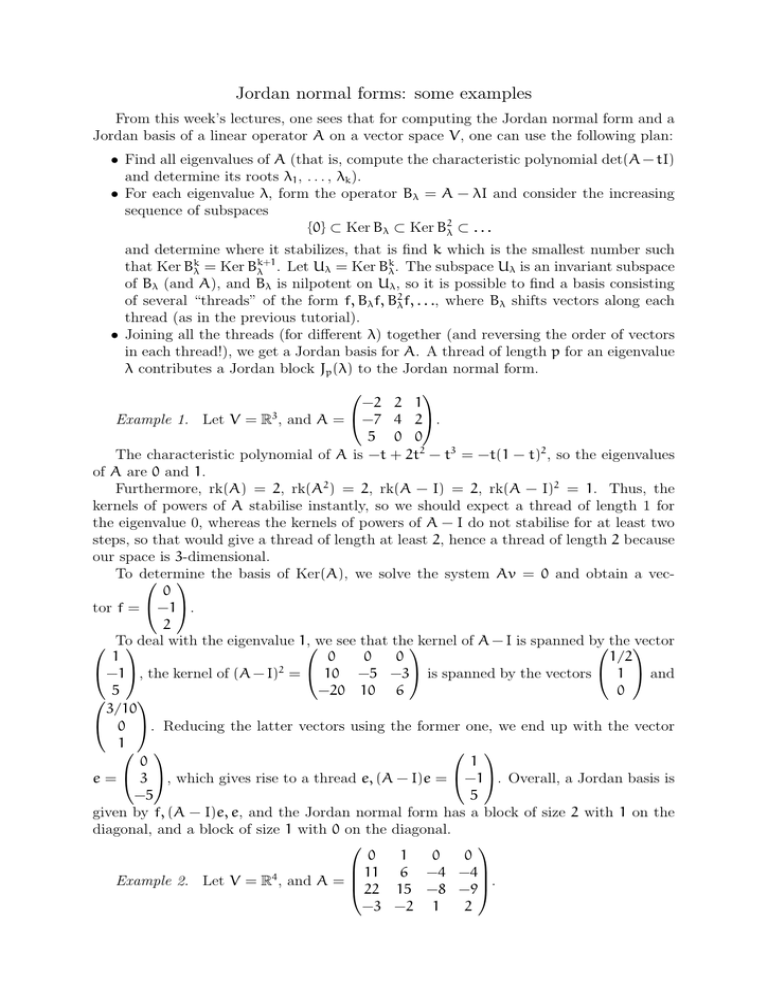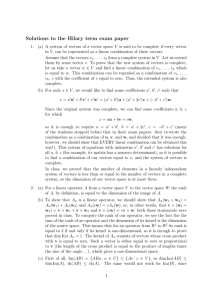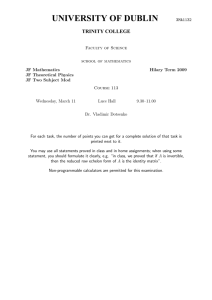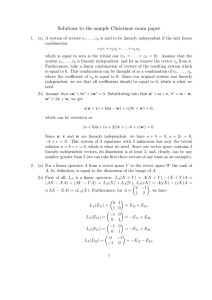Jordan normal forms: some examples
advertisement

Jordan normal forms: some examples
From this week’s lectures, one sees that for computing the Jordan normal form and a
Jordan basis of a linear operator A on a vector space V, one can use the following plan:
• Find all eigenvalues of A (that is, compute the characteristic polynomial det(A − tI)
and determine its roots λ1 , . . . , λk ).
• For each eigenvalue λ, form the operator Bλ = A − λI and consider the increasing
sequence of subspaces
{0} ⊂ Ker Bλ ⊂ Ker B2λ ⊂ . . .
and determine where it stabilizes, that is find k which is the smallest number such
k
that Ker Bkλ = Ker Bk+1
λ . Let Uλ = Ker Bλ . The subspace Uλ is an invariant subspace
of Bλ (and A), and Bλ is nilpotent on Uλ , so it is possible to find a basis consisting
of several “threads” of the form f, Bλ f, B2λ f, . . ., where Bλ shifts vectors along each
thread (as in the previous tutorial).
• Joining all the threads (for different λ) together (and reversing the order of vectors
in each thread!), we get a Jordan basis for A. A thread of length p for an eigenvalue
λ contributes a Jordan block Jp (λ) to the Jordan normal form.
−2 2 1
Example 1. Let V = R3 , and A = −7 4 2.
5 0 0
The characteristic polynomial of A is −t + 2t2 − t3 = −t(1 − t)2 , so the eigenvalues
of A are 0 and 1.
Furthermore, rk(A) = 2, rk(A2 ) = 2, rk(A − I) = 2, rk(A − I)2 = 1. Thus, the
kernels of powers of A stabilise instantly, so we should expect a thread of length 1 for
the eigenvalue 0, whereas the kernels of powers of A − I do not stabilise for at least two
steps, so that would give a thread of length at least 2, hence a thread of length 2 because
our space is 3-dimensional.
To determine
the basis of Ker(A), we solve the system Av = 0 and obtain a vec0
tor f = −1.
2
To
deal
with the eigenvalue 1,we see that thekernel of A − I is spanned by
vector
the
1
0
0
0
1/2
−1, the kernel of (A − I)2 = 10 −5 −3 is spanned by the vectors 1 and
−20 10 6
0
5
3/10
0 . Reducing the latter vectors using the former one, we end up with the vector
1
0
1
e = 3 , which gives rise to a thread e, (A − I)e = −1. Overall, a Jordan basis is
−5
5
given by f, (A − I)e, e, and the Jordan normal form has a block of size 2 with 1 on the
diagonal, and a block of size 1 with 0 on the diagonal.
0
1
0
0
11 6 −4 −4
Example 2. Let V = R4 , and A =
22 15 −8 −9.
−3 −2 1
2
The characteristic polynomial of A is 1 − 2t2 + t4 = (1 + t)2 (1 − t)2 , so the eigenvalues
of A are −1 and 1.
To avoid unnecessary calculations (similar to avoiding computing (A − I)3 in the previous example),
let us compute the ranks
For λ = −1
for both eigenvalues simultaneously.
1
1
0
0
12
8 −4 −4
11 7 −4 −4
12
8 −4 −4
2
we have A+I =
22 15 −7 −9, rk(A+I) = 3, (A+I) = 60 40 −20 −24,
−3 −2 1
3
−12 −8 4
8
−1 1
0
0
11
5
−4
−4
rk((A + I)2 ) = 2. For λ = 1 we have A − I =
22 15 −9 −9, rk(A − I) = 3,
−3 −2 1
1
12
4 −4 −4
−32 −16 12 12
2
(A − I)2 =
−28 −20 12 12 , rk((A − I) ) = 2. Thus, each of these eigenvalues
0
0
0
0
gives rise to a thread of length at least 2, and since our vector space is 4-dimensional,
each of the threads should be of length 2, and in each case the stabilisation happens on
the second step.
In the case of the eigenvalue −1, we first
determine
the kernel of A + I, solving the
−1
1
system (A + I)v = 0; this gives us a vector
−1. The equations that determine the
0
kernel of (A + I)2 are t = 0, 3x + 2y
=
z
so
y
and
z arefree variables, and for the basis
1/3
−2/3
0
1
vectors of that kernel we can take
1 and 0 . Reducing the basis vectors of
0
0
2
Ker(A
+
I)
using
the
basis
vector
of
Ker(A
+
I),
we
end up with a relative basis vector
0
1
1
−1
e=
2, and a thread e, (A + I)e = 1 .
0
0
In the case of the eigenvalue 1, we first
determine
the kernel of A − I, solving the
0
0
system (A − I)v = 0; this gives us a vector
1 . The equations that determine the
−1
2
kernel of (A − I) are 4x = z + t, 4y
= z +
t so z and
t are
free variables, and for the basis
1/4
1/4
1/4
1/4
vectors of that kernel we can take
1 and 0 . Reducing the basis vectors of
0
1
Ker(A − I)2 using the basis vector of Ker(A + I), we end up with a relative basis vector
1/4
0
1/4
, and a thread e, (A − I)e = 0 .
f=
0
1/4
1
−1/4
Finally, the vectors
(A
+
I)e,
e,
(A
−
I)f,
f form a Jordan basis for A; the Jordan
−1 1 0 0
0 −1 0 0
.
normal form of A is
0
0 1 1
0
0 0 1
Example 3. V is arbitrary, all eigenvalues of V are different.
In this case, for every eigenvalue we get at least one thread of length 1 which altogether
is already enough to form a basis. Thus, we recover our old result: the eigenvectors form a
Jordan basis, and the Jordan normal form consists of blocks of size 1, so the corresponding
Jordan matrix is not just block-diagonal but really diagonal.
Example 4. How to use Jordan normal forms to compute something with matrices?
There are two main ideas: (1) to multiply block-diagonal matrices, one can multiply the
corresponding blocks, and (2) for a Jordan block Jp (λ) we have
n−p+1
n
n
λ nλn−1 n2 λn−2 . . . p−1
λ
n−p+2
n
n
n−1
0
λ
nλ
. . . p−2 λ
.
n
..
.
.
..
..
Jp (λ) = ..
.
...
.
0
0
...
λn
nλn−1
0
0
0
...
λn
n n
λ nλn−1
λ 1
.
=
In particular,
0
λn
0 λ
For example, to compute the nth powerof the matrix
from Example 1 in closed
0 0 0
form, we notice that C−1 AC = J, where J = 0 1 1 is its Jordan normal form, and
0 0 1
0
1
0
C = −1 −1 3 is the transition matrix to the Jordan basis (its columns form the
2
5 −5
Jordan
we have C−1 An C = Jn , and An = CJn C−1 . From the above formula,
basis). Thus,
0 0 0
Jn = 0 1 n, so we get
0 0 1
−3n + 1
2n
n
−2n + 6 −n + 3 .
An = 3n − 10
−15n + 20 10n − 10 5n − 5



